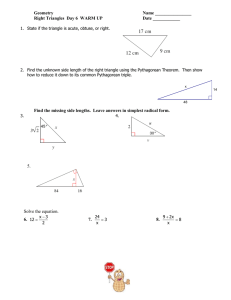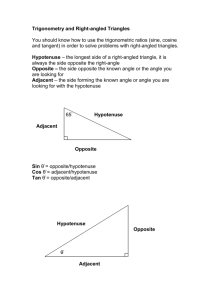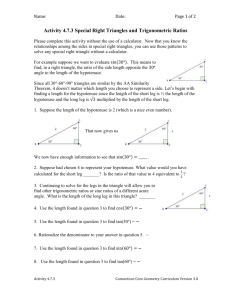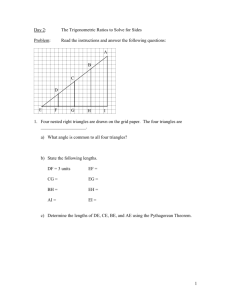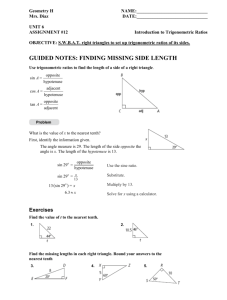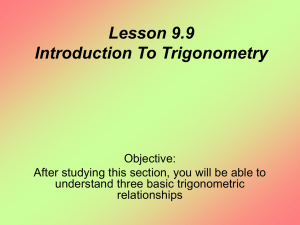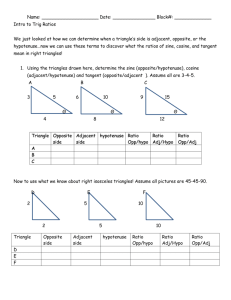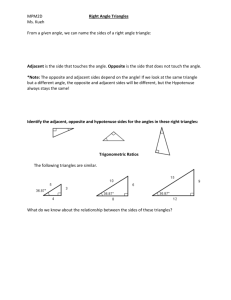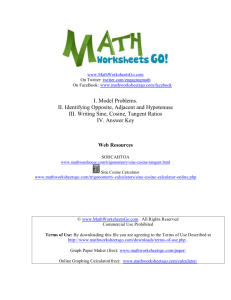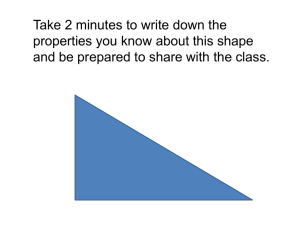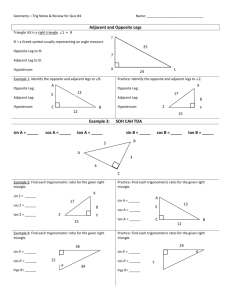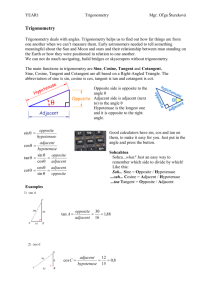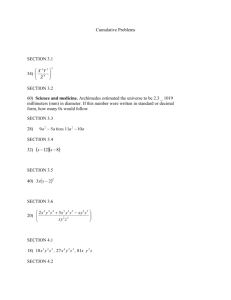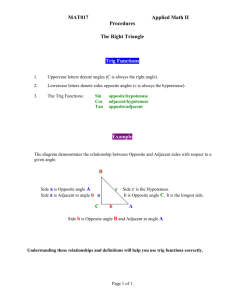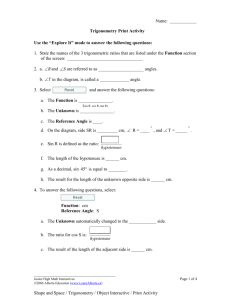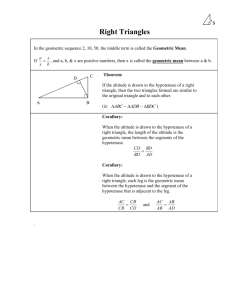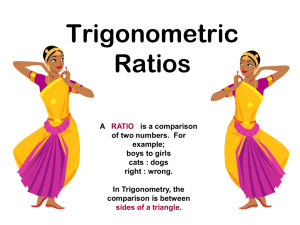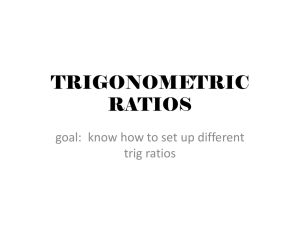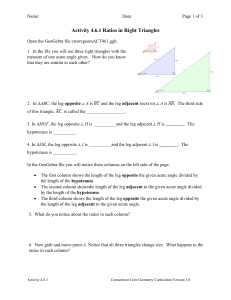Math Test Info/Review Packet
advertisement
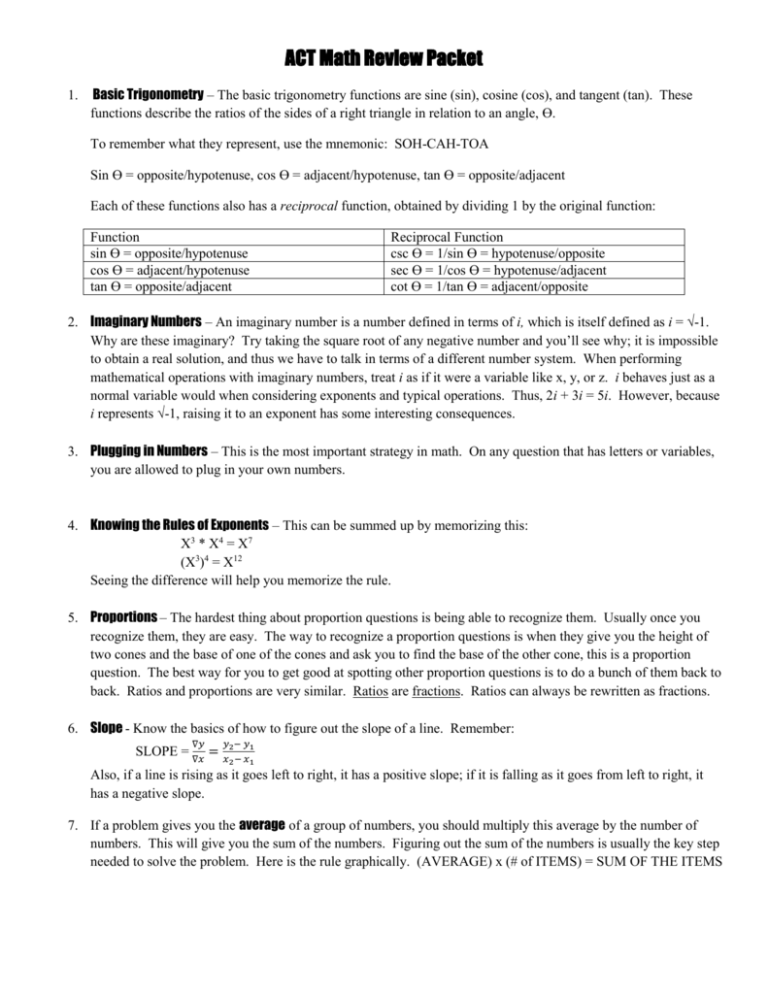
ACT Math Review Packet 1. Basic Trigonometry – The basic trigonometry functions are sine (sin), cosine (cos), and tangent (tan). These functions describe the ratios of the sides of a right triangle in relation to an angle, ϴ. To remember what they represent, use the mnemonic: SOH-CAH-TOA Sin ϴ = opposite/hypotenuse, cos ϴ = adjacent/hypotenuse, tan ϴ = opposite/adjacent Each of these functions also has a reciprocal function, obtained by dividing 1 by the original function: Function sin ϴ = opposite/hypotenuse cos ϴ = adjacent/hypotenuse tan ϴ = opposite/adjacent Reciprocal Function csc ϴ = 1/sin ϴ = hypotenuse/opposite sec ϴ = 1/cos ϴ = hypotenuse/adjacent cot ϴ = 1/tan ϴ = adjacent/opposite 2. Imaginary Numbers – An imaginary number is a number defined in terms of i, which is itself defined as i = √-1. Why are these imaginary? Try taking the square root of any negative number and you’ll see why; it is impossible to obtain a real solution, and thus we have to talk in terms of a different number system. When performing mathematical operations with imaginary numbers, treat i as if it were a variable like x, y, or z. i behaves just as a normal variable would when considering exponents and typical operations. Thus, 2i + 3i = 5i. However, because i represents √-1, raising it to an exponent has some interesting consequences. 3. Plugging in Numbers – This is the most important strategy in math. On any question that has letters or variables, you are allowed to plug in your own numbers. 4. Knowing the Rules of Exponents – This can be summed up by memorizing this: X3 * X4 = X 7 (X3)4 = X12 Seeing the difference will help you memorize the rule. 5. Proportions – The hardest thing about proportion questions is being able to recognize them. Usually once you recognize them, they are easy. The way to recognize a proportion questions is when they give you the height of two cones and the base of one of the cones and ask you to find the base of the other cone, this is a proportion question. The best way for you to get good at spotting other proportion questions is to do a bunch of them back to back. Ratios and proportions are very similar. Ratios are fractions. Ratios can always be rewritten as fractions. 6. Slope - Know the basics of how to figure out the slope of a line. Remember: ∇𝑦 𝑦 −𝑦 SLOPE = ∇𝑥 = 𝑥2 − 𝑥1 2 1 Also, if a line is rising as it goes left to right, it has a positive slope; if it is falling as it goes from left to right, it has a negative slope. 7. If a problem gives you the average of a group of numbers, you should multiply this average by the number of numbers. This will give you the sum of the numbers. Figuring out the sum of the numbers is usually the key step needed to solve the problem. Here is the rule graphically. (AVERAGE) x (# of ITEMS) = SUM OF THE ITEMS 8. Know the terms arithmetic mean, median, and mode. Arithmetic mean – is just another word for average. So just find the average of the numbers Median – the number that comes in the middle if you line the numbers up from smallest to biggest. Mode – the number that appears the most frequently. 9. Probability - The simplest way to solve a probability question is to use this concept: 𝑃𝐴𝑅𝑇 (𝑃𝑎𝑟𝑡 𝑡ℎ𝑎𝑡 𝑡ℎ𝑒𝑦 𝑎𝑟𝑒 𝑎𝑠𝑘𝑖𝑛𝑔 𝑎𝑏𝑜𝑢𝑡) (𝑇𝑜𝑡𝑎𝑙 𝑛𝑢𝑚𝑏𝑒𝑟 𝑜𝑓 𝑖𝑡𝑒𝑚𝑠) PROBABILITY = 𝑊𝐻𝑂𝐿𝐸 10. Percent - The simplest way to do a percent question uses the exact same concept: 𝑃𝐴𝑅𝑇 PERCENT = 𝑊𝐻𝑂𝐿𝐸 (𝑃𝑎𝑟𝑡 𝑡ℎ𝑎𝑡 𝑡ℎ𝑒𝑦 𝑎𝑟𝑒 𝑎𝑠𝑘𝑖𝑛𝑔 𝑎𝑏𝑜𝑢𝑡) (𝑇𝑜𝑡𝑎𝑙 𝑛𝑢𝑚𝑏𝑒𝑟 𝑜𝑓 𝑖𝑡𝑒𝑚𝑠) 11. Percent increase or Percent decrease = 𝐶ℎ𝑎𝑛𝑔𝑒 𝑖𝑛 𝑡ℎ𝑒 𝑎𝑚𝑜𝑢𝑛𝑡 𝑂𝑟𝑖𝑔𝑖𝑛𝑎𝑙 𝐴𝑚𝑜𝑢𝑛𝑡 12. Questions involving remainders are the only type of questions that you can’t use your calculator to solve. You must work these out by hand. 13. Pythagorean Theorem – You will be tested on this formula frequently. On any question involving a right triangle, this should be the first formula you think of. 14. Parallel lines have equal slopes. Perpendicular lines have slopes that are negative reciprocals. 15. A rule with triangles – 2 sides of a triangle must add up to be more than the third side. 16. Is function questions, if you see f(4) = m, whatever is next to the “f” is always the x value. Therefore, you would plug in 4 for x and solve for y, or go over 4 on the x-axis and see what the y-value is when you hit the graph. If you see f(m) = 4, then you now the y-value is 4 and you look to see what x values would give you a y value of 4. 17. Here are a few words that have mathematical equivalents: Phrase or Word Sum, more than Difference, less than Product, times Of Quotient, ratio Is “a number” Math symbol + x x ÷ = (x, b, m) any variable When you see any of these words, try to take the word sentence in the question and turn it into a math equation. 18. When a question tells you that you want the greatest possible value for a number, you need to make the other values as small as possible. 19. Whenever there is a shape that is not a basic circle, square, rectangle, or triangle, try to split the shake up into these basic pieces. Also, on shaded area questions, you never have to know the formula for the area of a strange shape. Get the area of a couple of simple shapes and subtract. 20. If something is definitely going to happen, the probability is 1 or 100%. If something is definitely not going to happen, the probability is 0 or 0%. 21. If you double a number, you are increasing it by 100%. If you divide a number in half, you are decreasing it by 50%. a. Ex. If you go from producing 4 cars per day to 8 cars per day, what is your percentage increase? (Ans. Increase of 100%) b. Ex. If you go from producing 8 cars per day to 4 cars per day, what is your percentage decrease? (Ans. Decrease of 50%) 22. When numbers are in a set, you don’t count them twice if they are repeated. 23. Know the rule that as a fraction goes to a higher power, the fraction actually gets smaller. Know the rule that when you are working with an x2 question, there is a positive value and a negative value. Make sure to remember that as a negative number gets larger, its value gets smaller. a. Ex. -4 is larger than -7 24. Know how to get the Surface Area of a Rectangular Box. You find the area of each of the six sides and then you add the six areas together. 25. “f(x) + 2” means shift the graph UP 2. “f(x) – 2” means shift DOWN 2. 26. “f(x + 2)” means shift LEFT 2. “f(x - 2)” means shift RIGHT 2.
